
|
Luxembourg Stamps
|

|
Luxembourg Stamps
|
| January 30 | Grand Duke Jean -- Definitives (2 F, 10 F, 16 F) |
| March 6 | European City of Culture -- Logo |
| March 6 | Luxembourg, European City of Culture 1995 |
| March 6 | City of Luxembourg -- Panoramic View |
| May 15 | Europa -- Peace and Freedom |
| May 15 | Games of the Small States of Europe |
| May 15 | European Geodynamics and Seismology Center |
| May 15 | United Nations -- 50th Anniversary |
| May 15 | European Year of Nature Conservation |
| September 18 | Iceland-Luxembourg Air Route -- 40th Anniversary |
| September 18 | Tourism -- Erpeldange and Schengen |
| September 18 | Museums -- Country Art, Wine, Pottery |
| December 4 | Indigenous Trees I (Charity Issue) |
| December 4 | Christmas 1995 |

The design on this stamp is the official logo of the "Luxembourg, European City of Culture" event. The logo was designed by Jacques Nicolay of the IMEDIA Advertising Agency.
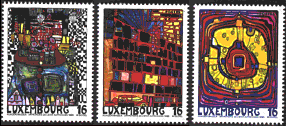
These three stamps were created especially for the European City of Culture event by the Austrian artist Friedensreich Hundertwasser. The three designs are "the King of the Antipodes", "the House with the Arcades and the Yellow Tower", and "the Small Path".

This se-tenant set was designed by the Luxembourg artist Carlo Losch from Mamer.
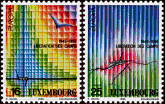
These stamps depict a graphic interpretation of the liberation of the concentration camps in 1945 within the framework of the general theme "Peace and Freedom".

The "Games of the Small States", featuring a broad range of sports activities, took place in Luxembourg from May 30 to June 3, 1995. Taking part were the eight European countries with populations of less than 1 million -- Andorra, Cyprus, Iceland, Liechtenstein, Malta, Monaco, San Marino, and Luxembourg.
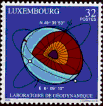
Since 1968, an underground geodynamics laboratory has been set up in a side gallery of a gypsum mine in Walferdange. This mine has a number of advantages, such as the absence of water, a reduced humidity, and a temperature stable within one hundredth of a degree Celsius. Some 22 instruments concerned with the science of geophysics - including seismographs registering the high speed waves originating from earthquakes - are in this mine. One of the research areas in geodynamics is the phenomenon of terrestrial tides on a planetary scale, the other the study of earthquakes either on a planetary scale or on a continental or regional one.

The United Nations is an international organization made up of deliberatory bodies, functional agencies, and temporary and permanent commissions made up of representatives of the member nations. The UN charter was drawn up by 50 countries in San Francisco in the spring of 1945. The official start of the UN was October 24, 1945.

More than 25 years ago, the Council of Europe launched its first nature conservation campaign. The result was a general awareness in Europe of the pressing need to protect our environment.
Today, it is necessary to go further. The size of the threats to the environment make it imperative to restate the necessity of nature conservation, not only in the protected areas, but throughout Europe in general. It is for this reason that the Council of Europe declared 1995 "European Year of Nature Conservation" with special emphasis on the conservation of nature outside the protected areas.

On May 22, 1955, a DC-4 Skymaster of Icelandic Airlines left Findel Airport in Luxembourg for the first flight to New York via Reykjavik, Iceland. The decision to establish a route between Luxembourg and the United States with a stopover in Iceland was perhaps one of the most important decisions ever made in the history of Icelandic aviation. Icelandic Airlines became pioneers in the international airline industry with its low-fare flights between Europe and the United States. The route owed its existence to the air-route agreements between Iceland, Luxembourg and the United States, in which there were no regulations on low fares, and the fare policy of Icelandic Airlines played an important role in the introduction of greater competition on the transatlantic routes between Europe and the United States. The Luxembourg route has been an influential factor in the development of international airline services in Iceland. It is, and has always been, the mainstay of the North Atlantic service of Icelandic Airlines (now known as Icelandair).
This was a joint issue with Iceland.
[1995 commemorative folder]
[FDC (Iceland)]
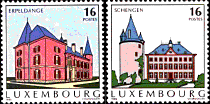
Erpeldange. The first stone-built castle, surrounded by a moat filled with water from the Sûre, was built in the 13th century by Frédéric and Gérard of Erpeldange. Around 1630, a new castle was built (shown on the stamp), which was of no military importance. It often changed owners over the centuries. In 1983, it was purchased by the government and it now houses the offices of the Erpeldange local authority.
Inside the chateau, two fireplaces of great artistic value, genuine Renaissance masterpieces, can be admired. The rooms with their panelling, and especially the impressive staircase, bear witness to the taste of the owners in the late 19th century, as well as to the skills of the craftsmen.
Schengen. Schengen, at the southern end of the Luxembourg Wine Route, was first mentioned under the name of "Sceidingas" in a document of 877. It is a rather quiet village, located in the three borders area; its main activities are winemaking and business with crossborder commuters and tourists. The bridge across the Moselle links Schengen to Germany and France.
Of the medieval castle, only the tower remains today. The other parts were pulled down, and a new castle was built by the ironmaster Jean-Nicolas Collart in 1812. The old tower and the new castle are shown on the stamp. On September 13, 1871 Victor Hugo stayed in the castle.
In Schengen, on June 14, 1985, Belgium, France, Germany, The Netherlands, and Luxembourg signed an agreement on the gradual abolition of checks on their common borders. The Schengen Agreement included measures to ease checks and drew up a list of attendant measures to be developed in order to guarantee security within this space without borders. The Schengen group later expanded through the adhesion of Austria, Greece, Italy, Portugal, and Spain. On Sunday, March 26, 1995, the free movement of persons guaranteed by the Schengen Agreement became a reality in a first phase among seven states of the European Union, viz: France, Germany, Portugal, Spain, and the Benelux countries.
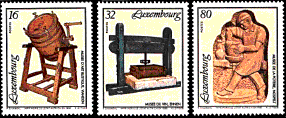
Country Art Museum at Vianden. Located since 1965 in a beautiful 18th century bourgeois house, the Country Art Museum of Vianden shows exhibits connected with all aspects of domestic life between 1750 and 1850. Its collections consist of elaborate furniture, documents, pictorial material and decorative features of dwelling areas, tools, and domestic apparatus. On the second floor there is a complete spinning and weaving workshop. A large number of authentic documents and photographic material about the town of Vianden and its history compete the exhibits with a very interesting local flavor. Pictured on the stamp is an antique butter churn.
Wine Museum at Ehnen. At Ehnen, on the Wine Route, a splendid old winemaking farm was taken over by the government in 1974. After their restoration, the main house and its annexes have housed the Wine Museum since 1978. The museum shows the history of vine-growing, the evolution of the equipment and the machinery through the centuries, and the various phases of work in the vineyard according to the seasons. It also houses an ancient cooper's workshop, a blacksmith's shop of yesteryear, and the former weights and measures office of the village. Pictured on the stamp is a wine-press.
Pottery Museum at Nospelt. From 1458 to 1914, qualified potters produced typical local earthenware in Nospelt; it was of simple form and handsomely decorated. Today, Nospelt has about 600 inhabitants and is well known for many activities connected with the pottery craft. The local tourist association runs an interesting pottery museum and every year on Easter Monday it organizes an Emaischen festival which features an arts & crafts market and pottery exhibitions. Pictured on the stamp is a sculpture by Léon Nosbusch (1897-1979) which was placed in the Nospelt town square in 1973.

Four trees native to Luxembourg are pictured on the stamps of this semipostal set for the benefit of charity:

This semipostal stamp shows the Holy Family on a stained-glass window from the parish church of Alzingen. The window was made in the Jansen workshops in Trier in 1920.